Kim Rendfeld's Blog, page 37
September 19, 2012
“The Cross and the Dragon” featured on Reading the Past
Author and fellow Historical Novel Society member Sarah Johnson is featuring The Cross and the Dragon and an interview with me on her book review blog, Reading the Past. About The Cross and the Dragon, Sarah says, “I enjoyed seeing how she wove material from this ancient story into a historically accurate backdrop, one full of beautiful descriptions of the Rhine Valley, while fleshing out the characters and their motivations.”
Calling Sarah a fellow HNS member is an understatement. A tireless volunteer, Sarah is the reviews editor of Historical Novels Review and maintains the HNS website. Two of her books deal with historical fiction and readers’ advisory topics: Historical Fiction: A Guide to the Genre (2005) and its sequel, Historical Fiction II (2009). All this on top of her day job as a longtime reference/electronic resources librarian at Eastern Illinois University.
Here is a sampling of Sarah’s thought-provoking questions:
You’ve written about being inspired by a romantic legend surrounding the ruins at Rolandsbogen in Germany, one that reinterprets characters from “The Song of Roland.” What inspired you to work in mentions of the myth of Siegfried and the dragon as well?
I especially enjoyed the many scenes that were set in the Benedictine abbey at Nonnenwerth and the Abbey of St. Stephen, since they emphasized the importance of religion, as well as people’s internal conflicts between godliness and worldliness. How did you set out to re-create the mindset of this very different time?
In reading The Cross and the Dragon, I got the impression you gave considerable thought to character names. Was there ever any question in your mind about using Frankish names for your main characters, rather than the more familiar ones taken from the poem?
Alda changes over the course of the novel from a romantically inclined teenager to a still willful but less impulsive young woman, one who matures after being touched by loss. Did you find any stage in her life easier or more challenging to write about?
Hint: One of the answers has something to do with the painting below. Find out the answers to these questions and more at Reading the Past.
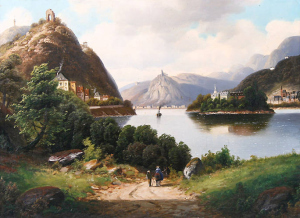
This circa 1870 painting by Arnold Forstmann (1842–after 1914) shows Nonnenwerth, along with Rolandsbogen and Drachenfels. (Public domain image via Wikimedia Commons.)


September 14, 2012
On the Other Side Notebook: Interview at Spann of Time
Fellow novelist and Historical Novel Society member Susan Spann has interviewed me about my journey as a writer and my writing process for my medieval tale, The Cross and the Dragon. Check out her blog, Spann of Time.
Susan writes the Shinobi mysteries, featuring a master ninja and his Portuguese Jesuit sidekick, and the first book will be published next spring.
Here is a sampling of Susan’s thought-provoking questions:
If you could go back in time and share one writing lesson with “new writer you” before starting your first manuscript … what would that be?
Will you tell us a little about the legend that inspired your novel, The Cross and the Dragon?
Authors of historical fiction strike a balance between historical accuracy and storytelling. How do you decide where to draw the line between fiction and history?
How long did it take you to write The Cross and the Dragon, and what did you find most difficult about the writing process?
Hint: one of the answers has something to do with the illustration of the Rhineland scene below. Find the answers to these questions and more at Spann of Time.
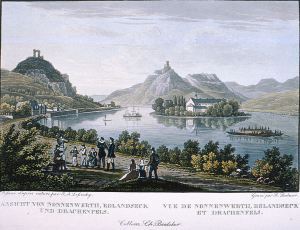
This circa 1830 illustration shows Nonnenwerth Island. In the distance are Rolandsbogen and Drachenfels. (Public domain image from Wikimedia Commons)


September 5, 2012
Researching Headgear for Eighth-Century Bishops
As I was reading over my proofs for The Cross and the Dragon, questions would pop into my mind, such as “Did they have that then?” In this case, that is miters, and then is eighth-century Francia, ruled by the king today known as Charlemagne.
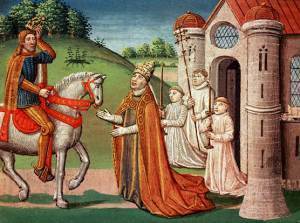
From Wikimedia Commons, public domain image
I had thought bishops always wore miters–large, pointed headdresses. After all, I had seen them in medieval imagery such as this 1493 miniature to the right from the Chronicles of France. Printed by Antoine Verard, it depicts Pope Hadrian I meeting Charlemagne. Problem is, that the image accurately shows armor and clothing from the 15th century, not the eighth.
Perhaps the realization that I had made an assumption made me turn to Wikipedia and Google Books, just to be sure.
I use Wikipedia as a starting point. I rarely read it for research, but it often links to authoritative sources. And it had public domain art that I can post. In this case, Wikipedia linked to an otherwise hard to find page in New Advent. From there, I got the obscure term camelaucum, a head-covering for eighth and ninth century popes on special occasions, and used it in my search through Google Books.
So, I learned popes of this era occasionally wore a helmet or cone-shaped headdress, but what about my characters, two bishops in the March of Brittany?
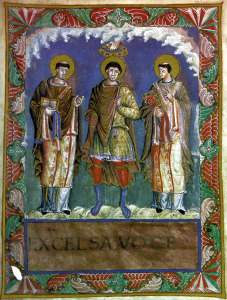
Public domain image from Wikimedia Commons
The conclusion, one website and parts of three books later: eighth-century bishops didn’t wear miters. Miters came about much later, and for bishops outside Rome, that might be the 11th century. Instead, a bishop would wear a frigium, but only outdoors and only for special occasions. In other words, I should have paid more attention to images like this one from the ninth century Sacramentary of Charles the Bald (also known as the Sacramentary of Metz) depicting a coronation. Note that the two clerics are bare-headed.
The two bishops in my novel are outdoors on special occasions–the return of the warriors from battle in Lombardy, and they might wear a frigium for that. One problem with the word frigium. Most 21st century readers don’t know what it means. Heck, I’d never heard of it until I was researching the headgear. Fortunately, my main characters likely wouldn’t have known the word, either, and allowed me to get away with a description, a pointed, white linen helmet.
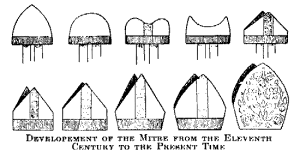
Public domain image via Wikimedia Commons, from The Catholic Encyclopedia published in 1911 and retrieved from New Advent.
Another surprise: The miter has changed over time as seen in the image on the right. The last is most familiar to today’s audience.
Fellow writers, have you ever thought something was part of your era, only to find it wasn’t? Please share.
Sources
New Advent: http://www.newadvent.org/cathen/10404a.htm
Church Vestments: Their Origin and Development by Herbert Norris
Vestments for All Seasons by Barbara Dee Baumgarten
The Ornaments of the Ministers by Percy Dearmer


August 29, 2012
Your Mission: Distill Your Novel to 200 Words or Less
As I was getting The Cross and the Dragon ready for publication, my editor had an assignment for me: write a blurb for the back of the book. In 100 to 200 words, tantalizingly describe approximately the first third of the plot.
[image error]No pressure. It’s only your readers’ first impression of your novel after the cover. Readers will only use this bit of information to decide whether they ought to spend time and money on the book.
Yet when it takes more than 100,000 words to tell the story, how does an author distill the essence of the novel into a mere 200 words–or less? Yet even though I’ve written teasers and headlines when I was a journalist, I found the process intimidating, and I couldn’t just recycle the pitch in my queries because it went much deeper into the plot than one third and contains a spoiler.
My quest to write the blurb that will work its magic involved reading current queries, older queries, the backs of the books that populate my nightstand and bookshelves, the Publishers Weekly review of the manuscript from the 2011 Amazon Breakthrough Novel Award competition, and the excerpt I’ve posted on my website.
Fellow authors, I hope you find this peek into my somewhat disorganized mind helpful when your editor asks you for a blurb.
First, a Headline
One commonality in the blurbs of published books is that many of them start with one sentence to capture the story, actually a fragment of a sentence. My older query letters call The Cross and the Dragon a tale of “an eighth-century Frankish warrior and his lady who are willing to sacrifice everything for love.” True, but that does not set this novel set apart from other love stories.
Riffing off a phrase from Publishers Weekly, I came up with “A tale of love in an era of war and blood feuds …” Did I mention many blurbs use ellipses?
OK. 12 words down. Only 88 more words to go.
Also element common to historical novels: dates. Pick a year in the 770s and a place. 86 more to go.
Next: Where There’s No Turning Back
I got to pondering the excerpt on my website and why I chose that scene–right after the villain realizes he’s been rejected–to tease readers to the book. The realization hit me: the scene is full of tension–and from that point in the story, there’s no going back. Eureka! That’s what I needed in the blurb.
Here is my first attempt at a blurb:
A tale of love in an era of war and blood feuds …
Francia, 774: Alda must escape marriage to Ganelon, a handsome count with a heart as black and twisted as a spent long in the hearth. Hruodland, the man she wants, is out of reach. After Hruodland rescued her from a beating at Ganelon’s hand a year ago, Alda thought she would never see him again. Yet here he is at her Rhineland home. And so is Ganelon.
As Alda and Hruodland’s love blossoms, Ganelon becomes more hateful by the day. And when Alda’s family decides Hruodland has the better offer, Ganelon explodes in rage and swears revenge.
What form will Ganelon’s vengeance take?
The above reveals how the story opens and the point of no return. But it feels too much like a summary, and it doesn’t give readers a sense of Alda’s character. Something was missing.
Step Three: Reveal the Character, Not the Spoiler
I again turned to my most recent queries and found that final piece. I could hint at the spoiler. Instead of revealing what happens, I could leave the situation open ended to build suspense and reveal who Alda is.
140 words later, I sent a draft to my editor. She liked it and made a few tweaks. Here is the final result, draft No. 5, as it appears on the back of the book:
A Tale of Love in an Era of War and Blood Feuds
Francia, 778: Alda has never forgotten Ganelon’s vow of vengeance when she married his rival, Hruodland. Yet the jilted suitor’s malice is nothing compared to Alda’s premonition of disaster for her beloved, battle-scarred husband.
Although the army invading Hispania is the largest ever and King Charles has never lost a war, Alda cannot shake her anxiety. Determined to keep Hruodland from harm, even if it exposes her to danger, Alda gives him a charmed dragon amulet.
Is its magic enough to keep Alda’s worst fears from coming true—and protect her from Ganelon?
Inspired by legend and painstakingly researched, The Cross and the Dragon is a story of tenderness, sacrifice, lies, and revenge in the early years of Charlemagne’s reign, told by a fresh, new voice in historical fiction.
If you like the blurb, I invite you to read the first chapter. Fellow writers, what techniques and sources did you use to craft that magical 100 to 200 words to entice your readers?


August 20, 2012
Stepping into a Medieval Spanish Civil War
Thanks to anonymous medieval epic, “The Song of Roland,” the battle at the Pass of Roncevaux in Spain is seen as Christianity vs. Islam. While the poem has a lot to say about courage in the face of overwhelming odds, any resemblance between it and the facts is purely coincidental.
The people responsible for the 778 massacre were Basques, not Saracens. In fact, the nobleman who persuaded Charlemagne to cross the Pyrenees and invade Spain was a Saracen seeking assistance to fight a fellow Muslim. For more about the emir, Sulaiman Yaqzan ibn al-Arabi, and why he sought aid from a devout Christian king, read my post on author Jessica Knauss’s blog.
And if you would like to learn more about the massacre–so traumatic that no one wrote about while Charlemagne was still alive–read a post I wrote in May for Unusual Historicals.
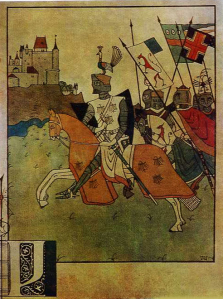
Illustration to “The Song of Roland,” 1903, Heorhiy Narbut (public domain image via wikipaintings.org)


August 19, 2012
Q and A about ‘The Cross and the Dragon’ on Unusual Historicals

Rolandsbogen (photo by Tohma via Wikimedia Commons, used under the terms of the GNU Free Documentation License)
What do an ivy-covered arch, four nonfiction books, and a painting about “The Song of Roland” have in common?
They all relate to the answers to questions about The Cross and the Dragon on this Sunday’s Unusual Historicals, a blog dedicated to fiction in unusual places and times. My debut novel, published by Fireship Press, is a tale of love amid the wars and blood feuds of Charlemagne’s reign.
Here are the questions:
From Diane Denton: How was the idea for your novel born? Obviously, you have an interest in the period, but what moved you to focus on the characters and their story as you did?
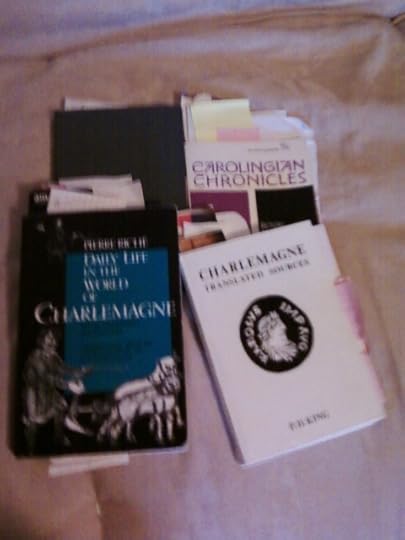
Four great resources about the Carolingians (photo by Kim Rendfeld)
From Sandy Frykholm: I think of the early Middle Ages as a fairly dry period for source material. What variety of sources did you find? Any that particularly surprised you—either in content or the fact that they exist at all?
From Roseanne E. Lortz: How did the epic poem “The Song of Roland” influence you in your writing? Are there elements in the novel that you took from the poem?
Visit Unusual Historicals for the answers.
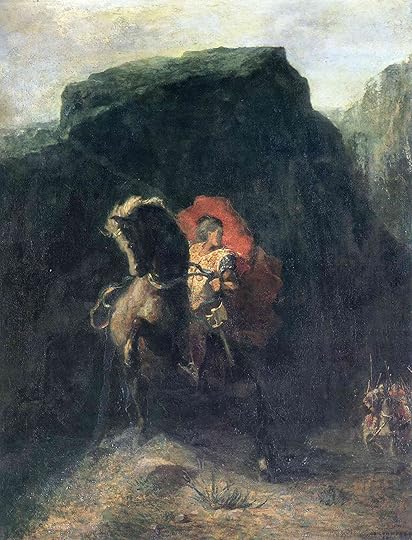
Roland at Roncesvalles, Odilon Redon, c.1869 (public domain image via Wikipaintings)


August 16, 2012
Another Preview of ‘The Cross and the Dragon’
This week, I’m visiting Unusual Historicals, a blog dedicated to fiction in unusual settings, for Excerpt Thursday. The excerpt is a scene referred to in the blurb of my debut novel, The Cross and the Dragon, set in the earlier years of Charlemagne’s reign.
[image error]As the Frankish army prepares to invade Hispania, Countess Alda has a premonition of disaster for Hruodland, her beloved, battle-scarred husband. Determined to keep him from harm, even if it exposes her to danger, Alda gives him a charmed dragon amulet.
Visit Unusual Historicals and read the excerpt.
Coming Sunday: An interview on Unusual Historicals with questions from readers and your chance to win an e-book.


August 12, 2012
Centuries and an ocean away
My local newspaper, The Courier-Times in New Castle, Indiana, ran a story about me and my book on Saturday, August 11. It is reposted here, with permission.–Kim
‘The Cross and the Dragon’ is new novel written by New Castle resident
Donna Cronk
Neighbors Editor
 Writer Kim Rendfeld has never lost her love of reading about legends and fairy tales.
Writer Kim Rendfeld has never lost her love of reading about legends and fairy tales.
In fact, she enjoys them so much that she crafts her own stories. She is the newly published author of a work of historical fiction, “The Cross and the Dragon.” The novel, available now in the Friends of the Library Gift Shop in the New Castle-Henry County Public Library, is $18.95 plus tax. Copies purchased in the gift shop benefit local reading programs, Noteworthy concerts and projects not covered by tax dollars.
[image error]The printed book is also available through Amazon and Barnes & Noble for around $20 and e-books are $7.50.
The novelist received a boost in 2011 when Publishers Weekly reviewed her pre-publication manuscript in the Amazon Breakthrough Novel Award competition. It was named a quarterfinalist. In a review for the periodical, Rendfeld’s unedited work was called “a pleasure to dive in to …” Other terms the publication used to describe her work include “beautifully crafted” and “elegant.”
Rendfeld describes her story as that of “a young Frankish noblewoman who must contend with a jilted suitor bent on revenge and the anxiety that her husband will be killed during the coming war in Spain. It is set in eighth-century Francia, which included today’s France, Germany, Holland, Belgium, Luxembourg and Switzerland.” More information about the author’s fiction is found on her website, www.kimrendfeld.com.
She finds the Middle Ages a fascinating period in which the political and personal intertwine. But she’s not longing for a time machine. “I am really, really glad to be living in 21st century America, when family scandals among leaders is fodder for the tabloids, not cause for war.”
A six-year New Castle resident, the author moved to town with her husband, Randy, managing editor of The Courier-Times. She has enjoyed an extensive career in various aspects of journalism and communications. Currently, Rendfeld is senior manager of editorial services at Ball State University where she copy edits university communications through publications, news releases and Web copy.
Roots
A native of Silver Spring, Md., the author was reared in Ridgefield, N.J. where she resided with her mother. Summers were spent in Kansas with her father, stepmother and brother. Her bachelor’s degree in English and journalism is from Indiana University and her newspaper career includes editor of the weekly Dunkirk News and Sun; education reporter for The (Muncie) Star and a decade at the Journal and Courier in Lafayette as editor of the Communities Page. There, she supervised a staff responsible “for almost anything readers cut out and pasted in their scrapbooks.” She was also interim editorial page editor.
Rendfeld has a grown stepdaughter, Suzanne Thomas and is grandma to Caitlin, age 11 and McKell, 3. At home in New Castle, she enjoys gardening and cooking, serving on the Friends of the Library board and attending First United Methodist Church. She sometimes volunteers at the library.
Fairy-Tale Fun
“I’ve been interested in fairy tales as long as I can remember,” Rendfeld says. “When I was little, my mother read books with the Disney versions of Cinderella and Snow White and I had those beautifully illustrated Flower Fairy books. When I was a teenager, I became engrossed with the folk tales collected by the Grimm brothers, much darker than Disney, and I enjoyed The Enchanted World series, which covered various myths, legends and folk tales.”
As a teen, her interest turned to the The Lord of the Rings and Mary Stewart’s Crystal Cave series.
Still today, she reads a lot in the historical fiction genre. “One reason is the simple enjoyment of getting lost in another time and place, which might be why I also have a soft spot for fantasy and science fiction. Another reason I read historical fiction is to support the genre in which I wish to write.”
What’s Ahead
Her next project is polishing the manuscript for her next book, tentatively titled “The Ashes of Heaven’s Pillar,” also set in eighth-century Europe.
But for now, Rendfeld is enjoying the ride as a newly published author. She would be happy to speak to groups about her book. If interested, contact her at kim (at) kimrendfeld (dot) com.
When her work was accepted for publication by Fireship Press in Tucson, Ariz., she says she was “ecstatic.
“My journey to publication took several years and many, many revisions,” Rendfeld says. “When the contract was negotiated and signed, I at first had a feeling of disbelief. Another writer describes the feeling like the Velveteen Rabbit saying, ‘I’m real.’”
Rendfeld says she has more people to thank for their help than there is space in an article. “But I cannot say enough of the support Randy gave me as I spent hours and hours at my computer, my mind centuries and an ocean away.”


August 7, 2012
Four Sources to Re-create Eighth-Century Francia
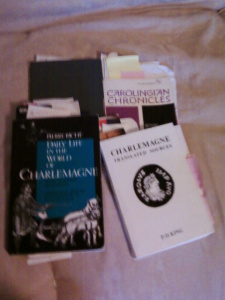 My publisher, Fireship Press, is compiling an annotated bibliography of the sources its authors use to re-create life in their periods. I’ve posted resources for research at kimrendfeld.com, but here are four I found indispensable as I wrote The Cross and the Dragon, a love story amid the wars and blood feuds of Charlemagne’s reign.
My publisher, Fireship Press, is compiling an annotated bibliography of the sources its authors use to re-create life in their periods. I’ve posted resources for research at kimrendfeld.com, but here are four I found indispensable as I wrote The Cross and the Dragon, a love story amid the wars and blood feuds of Charlemagne’s reign.
Einhard’s The Life of Charlemagne—This biography of the emperor was written by one of his courtiers about 830-33, at least 16 years after Charles’s death, and like most primary sources of this era, has a definite point of view. In addition to accounts of Charles’s many wars, Einhard provides a physical description of the man and his habits and discuss the monarch’s relationships. He also includes a few events Charles would have rather not had recorded such as the massacre at Roncevaux.
Carolingian Chronicles—This collection includes the Royal Frankish Annals, original and revised, and Nithard’s Histories. The RFA has several anonymous authors in the eighth and ninth centuries. These give the freshest accounts of events and show you how the members of the society saw themselves and their adversaries. A warning: the authors of the original annals wanted to make their boss look good, even if that meant exaggerating some events and omitting others that made him look bad.
Nithard was one of Charlemagne’s grandsons, who sided with his cousin Charles the Bald in the civil war that tore apart Francia after Charlemagne’s death. His books recount events as he sees them from 814 to 843.
P.D. King’s Charlemagne: Translated Sources—This collection of annals, letters, contemporary biographies, capitularies, and more provides even more insight into the Carolingian era. The letters, especially, reveal attitudes and beliefs of the time period, and show the real human beings behind them. For example, Pope Stephen writes a strongly worded letter to Charlemagne and his brother urging them not to marry the daughter of his enemy. If American textbooks had material like this, more students would be interested in history.
Pierre Riché’s Daily Life in the World of Charlemagne (translated by JoAnn McNamara)—How often did people bathe? How did they heat and light their homes? How did they dress? Daily life books help fill in those kinds of details. Riché, a scholar, focuses on the Carolingians.
The truth is, I owe a lot to scholars who translated medieval Latin for modern-day audiences. I could not have re-created eighth century Francia without them. (Historical novelist’s disclaimer: Any mistakes are mine and mine alone.)
Writers, what sources can you not do without as you craft your stories?


July 31, 2012
Help Wanted: What Would You Like to Know about ‘The Cross and the Dragon’?
On August 19, I’m going to be interviewed by Unusual Historicals, and we would like your help. We’re asking readers for their questions about my debut novel, The Cross and the Dragon, published by Fireship Press. (If you’d like to read an excerpt, visit Unusual Historicals on August 16.)
What is The Cross and the Dragon about? So glad you asked:
A tale of love in an era of war and blood feuds.
[image error]Francia, 778: Alda has never forgotten Ganelon’s vow of vengeance when she married his rival, Hruodland. Yet the jilted suitor’s malice is nothing compared to Alda’s premonition of disaster for her beloved, battle-scarred husband.
Although the army invading Hispania is the largest ever and King Charles has never lost a war, Alda cannot shake her anxiety. Determined to keep Hruodland from harm, even if it exposes her to danger, Alda gives him a charmed dragon amulet.
Is its magic enough to keep Alda’s worst fears from coming true—and protect her from Ganelon?
Inspired by legend and painstakingly researched, The Cross and the Dragon is a story of tenderness, sacrifice, lies, and revenge in the early years of Charlemagne’s reign.
Curious about what compelled me choose this era? What sources I used for research? Something else? Leave a question in the comments below by August 8. We’ll use the top five, a combination of the most frequently asked and the most interesting.





